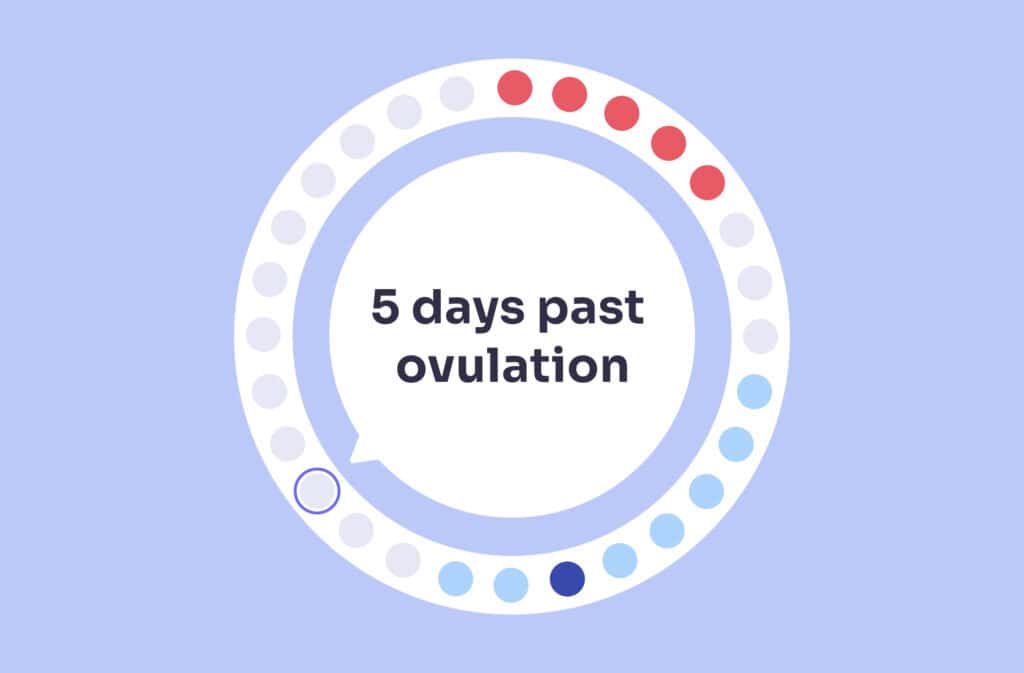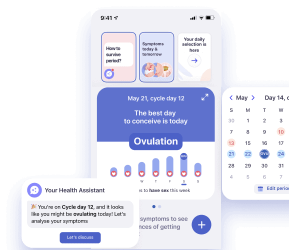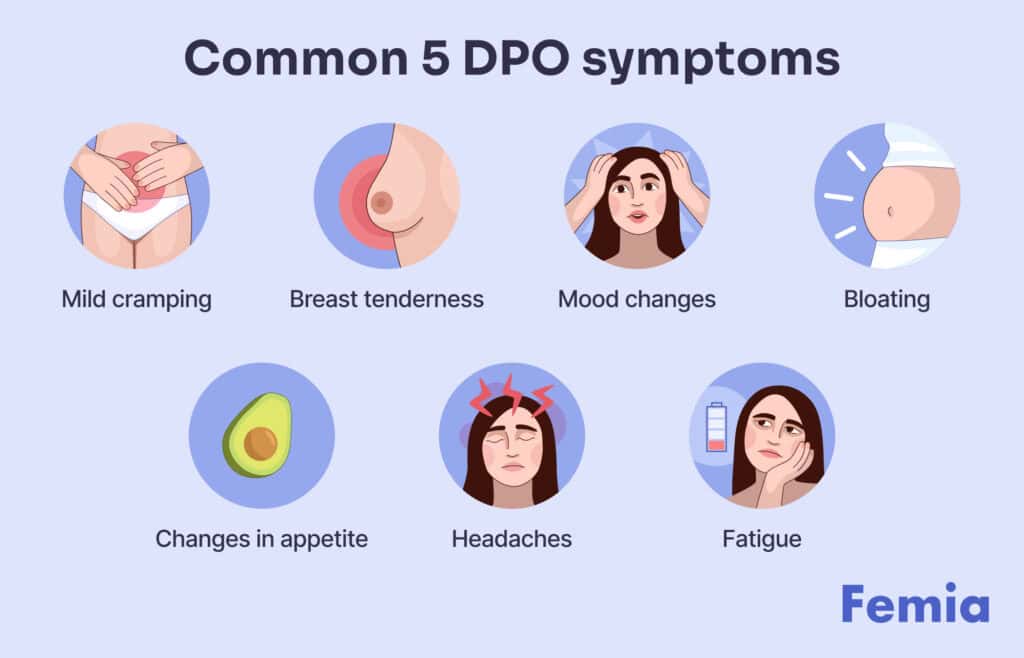Femia > Health Library > Getting Pregnant > Trying to conceive > 5 DPO: What to expect, and how to tell if you’re pregnant
5 DPO: What to expect, and how to tell if you’re pregnant

- Updated Feb 25, 2025
- Published
CRAFTED BY HUMAN
Crafted by human At Femia, we provide accurate and up-to-date information at every stage of your journey, from trying to conceive, pregnancy and postnatal support. All content is created by a real person based on in-depth research and own professional experience. Femia ensures that you will receive expert advice, strict accuracy and a personalized approach from our authors/medical experts. Learn more about our editorial policy.
FACT CHECKED
Fact checked At Femia Health, we maintain the highest standards of editorial excellence in delivering content focused on helping you conceive, guiding you through pregnancy, and supporting you postpartum. Explore our content review principles to learn how we ensure the accuracy and quality of our health and lifestyle tips for every stage of your journey.
At 5 DPO (5 days past ovulation):
- If fertilization occurred, the zygote continues its journey through the fallopian tube.
- The uterine lining is thickening in preparation for potential implantation.
- Common symptoms may include mild cramping, breast tenderness, and mood changes, but these are due to normal hormonal fluctuations rather than pregnancy.
- It’s still too early for definitive pregnancy symptoms or accurate test results.
If you’re reading this, you’re likely in the midst of your two-week wait, specifically at 5 DPO (5 days past ovulation), to see if you will indeed miss your period. This can be both an exciting and anxious time, so let’s discuss what’s happening in your body and what you might be experiencing. Whether you’re actively trying to conceive or simply curious about your body’s processes, understanding the events at 5 DPO can provide valuable insights into your reproductive health.
➡️ Read other Femia guides in this series:
- 1 DPO: What to expect, and how to tell if you’re pregnant
- 2 DPO: What to expect, and how to tell if you’re pregnant
- 3 DPO: What to expect, and how to tell if you’re pregnant
- 4 DPO: What to expect, and how to tell if you’re pregnant
- 6 DPO: What to expect, and how to tell if you’re pregnant
- 7 DPO: What to expect, and how to tell if you’re pregnant
- 8 DPO: What to expect, and how to tell if you’re pregnant
- 9 DPO: What to expect, and how to tell if you’re pregnant
- 10 DPO: What to expect, and how to tell if you’re pregnant
- 11 DPO: What to expect, and how to tell if you’re pregnant
- 12 DPO: What to expect, and how to tell if you’re pregnant
- 13 DPO: What to expect, and how to tell if you’re pregnant
- 14 DPO: What to expect, and how to tell if you’re pregnant
- 15 DPO: What to expect, and how to tell if you’re pregnant
- 16 DPO: What to expect, and how to tell if you’re pregnant
What does 5 DPO mean?
5 DPO stands for “5 days past ovulation.” It marks the fifth day of your luteal phase, which is the second half of your menstrual cycle. This phase typically lasts about 14 days, though it can vary from woman to woman and cycle to cycle. During this time, your body is preparing for the possibility of pregnancy, regardless of whether fertilization has occurred.

What's happening in your body at 5 DPO?
At 5 days post ovulation, several important processes are taking place in your body:
- Potential fertilization aftermath. If fertilization occurred during ovulation or shortly after, the fertilized egg (now called a zygote) continues its journey through the fallopian tube. It’s gradually making its way towards the uterus.
- Cellular division. The zygote is undergoing rapid cell division, transforming from a single cell into a cluster of cells called a morula.
- Hormonal changes. Your body is producing increasing amounts of progesterone and estrogen. These hormones play crucial roles in preparing your uterus for potential implantation.
- Uterine lining changes. The lining of your uterus (endometrium) is continuing to thicken and become more vascularized, creating a nurturing environment for a potential embryo.
- Cervical mucus changes. You may notice changes in your cervical mucus. At 5 DPO, it often becomes thicker and less abundant as compared to during or before ovulation.
👉Find out more: How long after sex does implantation occur: Understanding the timeline
Common 5 DPO symptoms
You might be wondering if your 5 DPO symptoms could be early signs of pregnancy. While it’s exciting to look for clues, keep in mind that at 5 DPO, any symptoms you’re feeling are more likely due to the normal hormonal dance of your luteal phase rather than pregnancy.
It’s important to remember that every woman’s experience is unique. Some report feeling one or more of the following symptoms:

- Mild cramping. Some women experience light cramping around this time. This could be due to the continued effects of ovulation or the ongoing hormonal changes in your body.
- Breast tenderness. Your breasts might feel sore or more sensitive than usual due to the rise in progesterone as the luteal phase begins.
- Fatigue. You might feel more tired than usual as your body works hard to support a potential pregnancy.
- Mood changes. Hormonal fluctuations can affect your mood, leading to irritability, anxiety, or emotional sensitivity.
- Bloating. Some women report feeling bloated or experience digestive changes at this stage of their cycle.
- Headaches. Hormonal shifts can sometimes trigger headaches for some women.
- Changes in appetite. You might notice slight changes in your food preferences or hunger levels.
Remember, whether you’re experiencing all, some, or none of these symptoms, it doesn’t necessarily mean you’re pregnant or not. Our bodies are wonderfully complex, and each one responds to these hormonal changes in its own unique way. The best thing you can do is listen to your body, take care of yourself, and try to stay patient as you navigate this waiting period.
5 DPO discharge if pregnant
Many women pay close attention to their cervical mucus as a potential early sign of pregnancy. At 5 DPO, you might notice changes in your discharge, but it’s important to understand that these changes occur regardless of whether or a pregnancy is beginning.
Typically, 5 DPO discharge if pregnant doesn’t differ significantly from non-pregnant discharge at this stage. Here’s what you might observe:
- Thick and creamy. After ovulation, cervical mucus often becomes thicker and creamier due to increased progesterone levels.
- Less abundant. You may notice less discharge than during your ovulation window several days ago.
- White or yellow tint. The discharge may appear white or slightly yellow in color.
While some women claim to notice distinctive changes in their cervical mucus early in pregnancy, scientific evidence doesn’t support this as a reliable indicator of pregnancy at 5 DPO. Any changes you observe are more likely due to the normal hormonal fluctuations of your menstrual cycle.
👉Find out more: Ultimate pre-pregnancy checklist: Essential steps to take before having a baby
5 DPO symptoms success stories
While it’s important to approach anecdotal evidence with caution, some women report experiencing early symptoms that they later attribute to pregnancy. These 5 DPO symptoms success stories often include:
- Intuition. Some women describe having a strong feeling or knowing that they’re pregnant.
- Unusual fatigue. Extreme tiredness that’s out of the ordinary for them.
- Heightened sense of smell. Noticing odors more intensely than usual.
- Mild nausea. Although morning sickness typically doesn’t start this early, some women report feeling queasy.
- Vivid dreams. Changes in sleep patterns or more vivid dreams than usual.
While these stories can be encouraging, it’s essential to remember that every pregnancy is unique, and the majority of women won’t experience noticeable symptoms this early. Many of these reported symptoms can also be attributed to normal luteal phase changes or other factors.
@femia.fertility We know that you want results ASAP! But you should wait a bit longer to ensure the test gives you accurate results #pregnancytest #5DPO #earlypregnancy #CutMeme #greenscreenmeme #ttc #ttccommunity #pregnancytracker #upt #plannedparenthood #femiafertilityapp ♬ original sound - Femia fertility app
Why am I cramping 3 days after ovulation?
Although this question refers to 3 DPO, it’s relevant to discuss cramping in the early days post-ovulation, including 5 DPO. Cramping in the early luteal phase is quite common and can have several causes:
- Ovulation aftermath. The process of ovulation itself can cause some residual discomfort that lasts for a few days.
- Hormonal changes: The shift in hormone levels, particularly the rise in progesterone, can cause mild uterine contractions leading to cramping.
- Implantation: Although 3-5 DPO is generally too early for implantation, some women might experience early implantation and associated cramping.
- Normal uterine activity: Your uterus is a muscle that can contract and relax, sometimes causing sensations similar to mild cramps.
- Digestive issues: Hormonal changes can affect your digestive system, leading to gas or bloating that might be mistaken for cramping.
If you’re experiencing severe pain or have concerns about your cramping, it’s always best to consult with a healthcare provider.

Can I take a 5 DPO pregnancy test?
If you’re eager to know whether you’re pregnant, you might be tempted to take a pregnancy test at 5 DPO. However, it isn’t recommended.
- Implantation hasn’t occurred yet. At 5 DPO, even if fertilization has taken place, the fertilized egg most likely hasn’t had time to implant in the uterus. Implantation typically occurs between 6-12 days after ovulation.
- No hCG production. Pregnancy tests detect the presence of human chorionic gonadotropin (hCG), a hormone produced after implantation. At 5 DPO, your body hasn’t started producing hCG yet.
- Risk of false negatives. In the unklikely case the fertilied egg has implanted in the uterus, hCG levels will be far below the threshold required for a positive pregnancy test result. Taking a test this early will almost certainly result in a negative result, even if you are pregnant. This can lead to unnecessary disappointment.
- Not cost-effective. Pregnancy tests can be expensive, and using them too early isn’t the best use of your resources.
For the most accurate results, it’s best to wait until at least the first day of your missed period before taking a pregnancy test.
If you’re finding it hard to wait, try to hold off until at least 12-14 DPO for a more reliable result. Remember, patience is key in this process, and waiting a few extra days can provide you with much more accurate information.
Progression of 5 DPO pregnancy test results
Given that 5 DPO is too early for a reliable pregnancy test, there isn’t a typical “progression” of test results starting from this day. The most reliable approach is to wait until you’ve missed your period before testing.
However, for those who do start testing early (which is not recommended), here’s what you might expect:
| 5-9 DPO | Tests are likely to be negative for everyone, regardless of whether conception has occurred. |
| 10-12 DPO | Some very early pregnancy tests might detect pregnancy in some women, but negative results are still common even in pregnant women. |
| 13-14 DPO | Most home pregnancy tests can detect pregnancy by this time if you're pregnant. |
| 15+ DPO | If your period is late and you're pregnant, you should get a clear positive result by this time. |
Questions from the Femia community
Here are some common questions we’ve received about the 5 DPO stage:
Can I experience implantation bleeding at 5 DPO?
While it's not impossible, 5 DPO is generally considered too early for implantation bleeding. Implantation typically occurs between 6-12 days after ovulation, with 8-10 days being the most common time frame. Any spotting at 5 DPO is more likely due to hormonal fluctuations or the residual effects of ovulation.
Is it normal to have mood swings at 5 DPO?
Yes, mood swings are quite normal at this stage of your cycle. The hormonal changes happening in your body, particularly with the rise in progesterone, can affect your mood. These changes occur whether you're pregnant or not.
My breasts are sore at 5 DPO. Am I pregnant?
Breast tenderness is a common symptom of the luteal phase of your cycle, regardless of whether you're pregnant. It's caused by an increase in progesterone that begins after ovulation. While it can be an early pregnancy symptom, at 5 DPO it's more likely just a sign that ovulation has occurred.
I'm not feeling any symptoms at 5 DPO. Does this mean I'm not pregnant?
Not at all! Many women don't feel any notable symptoms or differences in the first few days after they ovulate, whether they're pregnant or not. The absence of symptoms doesn't rule out pregnancy, just as having symptoms doesn't guarantee it either. Every woman's body responds differently to ovulation, the start of the luteal phase, and pregnancy.
The bottom line
At 5 DPO, your body is working hard to prepare for the possibility of a pregnancy. While it’s natural to be eager for signs, it’s important to remember that it’s still very early. Most women won’t experience noticeable pregnancy symptoms at this stage, and home pregnancy tests aren’t yet reliable.
The best approach during this time is to take care of yourself, stay positive, and try to be patient. If you’re trying to conceive and have concerns about your fertility or any symptoms you’re experiencing, don’t hesitate to reach out to your healthcare provider. They can provide personalized advice and support as you navigate your journey.
Remember, whether you’re experiencing cramping, curious about changes in your discharge, or wondering about other symptoms, your experience is unique to you. Trust in your body and give it time to do its work. The two-week wait can be challenging, but you’re not alone in this journey.
➡️ Read other Femia guides in this series:
- 1 DPO: What to expect, and how to tell if you’re pregnant
- 2 DPO: What to expect, and how to tell if you’re pregnant
- 3 DPO: What to expect, and how to tell if you’re pregnant
- 4 DPO: What to expect, and how to tell if you’re pregnant
- 6 DPO: What to expect, and how to tell if you’re pregnant
- 7 DPO: What to expect, and how to tell if you’re pregnant
- 8 DPO: What to expect, and how to tell if you’re pregnant
- 9 DPO: What to expect, and how to tell if you’re pregnant
- 10 DPO: What to expect, and how to tell if you’re pregnant
- 11 DPO: What to expect, and how to tell if you’re pregnant
- 12 DPO: What to expect, and how to tell if you’re pregnant
- 13 DPO: What to expect, and how to tell if you’re pregnant
- 14 DPO: What to expect, and how to tell if you’re pregnant
- 15 DPO: What to expect, and how to tell if you’re pregnant
- 16 DPO: What to expect, and how to tell if you’re pregnant
References
- Practice Committee of the American Society for Reproductive Medicine. “Optimizing Natural Fertility: A Committee Opinion.” Fertility and Sterility, vol. 107, no. 1, 2017, pp. 52-58. National Library of Medicine, https://pubmed.ncbi.nlm.nih.gov/28228319/.
- Norwitz, Errol R., et al. “Implantation and the Survival of Early Pregnancy.” New England Journal of Medicine, vol. 345, no. 19, 2001, pp. 1400-1408. National Library of Medicine, https://pubmed.ncbi.nlm.nih.gov/11794174/.
- American College of Obstetricians and Gynecologists. “Fertility Awareness-Based Methods of Family Planning.” ACOG Practice Bulletin No. 205, 2019. https://www.acog.org/womens-health/faqs/fertility-awareness-based-methods-of-family-planning.
- National Institutes of Health. “What are some common signs of pregnancy?” National Institute of Child Health and Human Development, 2017. https://www.nichd.nih.gov/health/topics/pregnancy/conditioninfo/signs.
- Mayo Clinic Staff. “Home pregnancy tests: Can you trust the results?” Mayo Clinic, 2022. https://www.mayoclinic.org/healthy-lifestyle/getting-pregnant/in-depth/home-pregnancy-tests/art-20047940.
- U.S. Food and Drug Administration. “Pregnancy.” FDA, 2019. https://www.fda.gov/medical-devices/home-use-tests/pregnancy.

Discover ways to enhance your sexual life after menopause through the physical changes you experience, while continuing to achieve fulfilling orgasms.

Discover a detailed week-by-week pregnancy checklist to ensure you’re fully prepared for your baby’s arrival. From initial preparations to postpartum care, we’ve got you covered.

A guide to UTIs covering the basics. Causes, symptoms, and how long do they take to clear up? Plus, the answer to the question can you have sex with a UTI?

